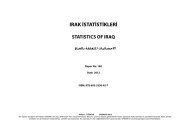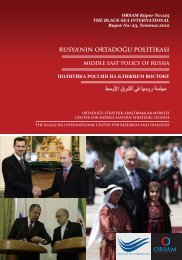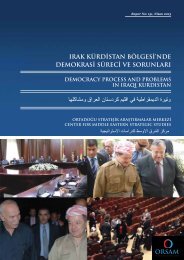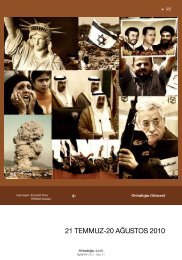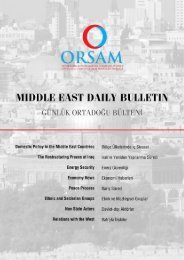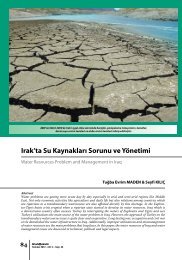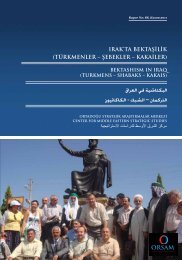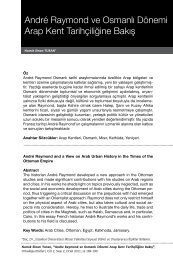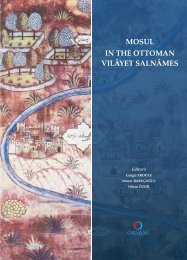turkmen in iraq and their flight - orsam
turkmen in iraq and their flight - orsam
turkmen in iraq and their flight - orsam
Create successful ePaper yourself
Turn your PDF publications into a flip-book with our unique Google optimized e-Paper software.
TURKMEN IN IRAQ AND THEIR FLIGHT: A DEMOCRAPHIC QUESTION<br />
ligious <strong>and</strong> ethnic groups <strong>in</strong> Iraq alive. These<br />
fears <strong>and</strong> delays of a census are closely l<strong>in</strong>ked<br />
to the dispute over oil-rich Kirkuk where Arabs,<br />
Kurds <strong>and</strong> Turkmen have <strong>in</strong>compatible<br />
claims. Absence of reliable data on population<br />
segments <strong>in</strong> Iraq is a huge drawback for any demographic<br />
analysis <strong>and</strong> therefore <strong>in</strong>dependent<br />
surveys are ever more important <strong>and</strong> crucial<br />
<strong>in</strong> underst<strong>and</strong><strong>in</strong>g <strong>and</strong> address<strong>in</strong>g social <strong>and</strong><br />
political problems <strong>in</strong> today’s Iraq. Nevertheless,<br />
because most registers <strong>in</strong> other countries,<br />
study<strong>in</strong>g Iraqi Turkmen diaspora was also not<br />
possible without a custom <strong>in</strong>dependent survey.<br />
In this study, we have collected <strong>in</strong>formation<br />
through two surveys. The first survey we have<br />
conducted <strong>in</strong> Iraq employed a r<strong>and</strong>omized<br />
sample of Iraqi Turkmen liv<strong>in</strong>g <strong>in</strong> a number of<br />
cities <strong>in</strong> Iraq while the second survey was carried<br />
out <strong>in</strong> major cities <strong>in</strong> Turkey used convenience<br />
sampl<strong>in</strong>g. Therefore, we cannot claim<br />
these two survey samples of be<strong>in</strong>g representative<br />
of overall Turkmen population <strong>in</strong> Iraq or<br />
Iraqi Turkmen diaspora community <strong>in</strong> Turkey.<br />
However, both surveys provide us a rich array<br />
of <strong>in</strong>formation that may help a better underst<strong>and</strong><strong>in</strong>g<br />
of <strong>their</strong> demographics <strong>and</strong> processes<br />
of <strong>in</strong>ternational mobility among Iraqi Turkmen.<br />
I believe this represents largely the best<br />
option particularly when one considers that<br />
these surveys were conducted <strong>in</strong> 2004, with<strong>in</strong><br />
a year of the 2003 <strong>in</strong>vasion which uprooted<br />
about 5 million Iraqis <strong>and</strong> caused a death tally<br />
over a million.<br />
International Migration Survey <strong>in</strong> Iraq<br />
Follow<strong>in</strong>g a preparation period, 40 <strong>in</strong>terviewers<br />
were tra<strong>in</strong>ed to adm<strong>in</strong>ister a four-module<br />
questionnaire to about 1400 r<strong>and</strong>omly selected<br />
Iraqi Turkmen households <strong>in</strong> selected cities<br />
<strong>and</strong> towns <strong>in</strong> Iraq where a sizeable Turkmen<br />
population is expected to exist accord<strong>in</strong>g to the<br />
past census results, literature <strong>and</strong> also on the<br />
basis of <strong>in</strong>terviews made with key <strong>in</strong>formants<br />
from the Iraqi Turkmen community <strong>in</strong> Turkey.<br />
Accord<strong>in</strong>gly cities <strong>and</strong> towns of Altunkopru,<br />
Baghdad, Besir, Dakuk, Erbil, Hanek<strong>in</strong>, Kirkuk,<br />
Musul, Suleymaniye, Taze, Telafer, Tuz, <strong>and</strong><br />
Zeynelabid<strong>in</strong> were selected. However, it had<br />
not been possible under the current conditions<br />
<strong>in</strong> Iraq to complete all <strong>in</strong>terviews as <strong>in</strong>itially<br />
planned. As a result, some areas had to be<br />
excluded due to high <strong>in</strong>security. Then our f<strong>in</strong>al<br />
sample size was reduced to 1040 households<br />
accommodat<strong>in</strong>g 5986 <strong>in</strong>dividuals (2992 females<br />
<strong>and</strong> 2994 males) <strong>in</strong> 12 cities <strong>and</strong> towns <strong>in</strong>stead<br />
of <strong>in</strong>itially planned 1500 households.<br />
In every town <strong>and</strong> city three districts were selected<br />
r<strong>and</strong>omly <strong>and</strong> with<strong>in</strong> each selected district<br />
one street was r<strong>and</strong>omly selected by the<br />
fieldworkers. Interviewers were sent to contact<br />
<strong>and</strong> conduct face to face <strong>in</strong>terviews with 15<br />
Turkmen households from each selected street.<br />
The method to select Turkmen households<br />
was visit<strong>in</strong>g houses beg<strong>in</strong>n<strong>in</strong>g with the first house<br />
(by door number) <strong>in</strong> the street until f<strong>in</strong>d<strong>in</strong>g<br />
a Turkmen household <strong>and</strong> cont<strong>in</strong>u<strong>in</strong>g the same<br />
procedure till complet<strong>in</strong>g 15 <strong>in</strong>terviews. Interviewers<br />
were allowed to ask help from these<br />
<strong>in</strong>itial Turkmen households to identify other<br />
Turkmen households <strong>in</strong> areas they are required<br />
to conduct <strong>in</strong>terviews. If the street accommodates<br />
too few households, the <strong>in</strong>terviewers are<br />
required to proceed to the next street on the<br />
right or left until the set number of <strong>in</strong>terviews<br />
<strong>in</strong> any selected area is completed. To facilitate<br />
the process, whenever possible we have sent <strong>in</strong>terviewers<br />
to the areas they are orig<strong>in</strong>ally from<br />
or to the areas they are familiar with.<br />
The questionnaire was designed to collect <strong>in</strong>formation<br />
on the households’ background characteristics<br />
<strong>in</strong>clud<strong>in</strong>g the size, liv<strong>in</strong>g conditions,<br />
employment <strong>and</strong> education status of members,<br />
relative wealth <strong>and</strong> liv<strong>in</strong>g st<strong>and</strong>ard compared<br />
to others liv<strong>in</strong>g <strong>in</strong> the same area, migration<br />
experiences of household members, if there is<br />
any, migrant’s decision mak<strong>in</strong>g processes <strong>and</strong><br />
factors <strong>in</strong>fluenc<strong>in</strong>g migration decision, along<br />
with the <strong>in</strong>formation about migration experiences<br />
of communities of which the household<br />
members are a part. Module A covered the<br />
www.<strong>orsam</strong>.org.tr<br />
13




